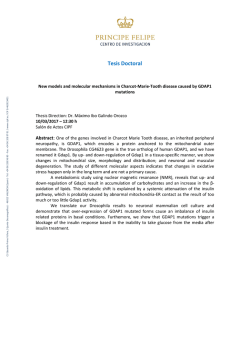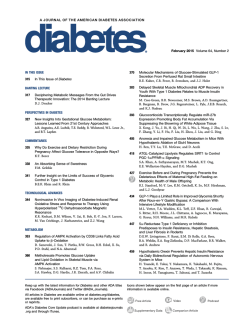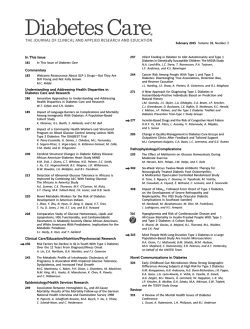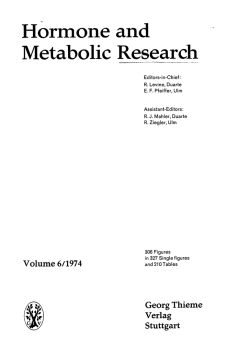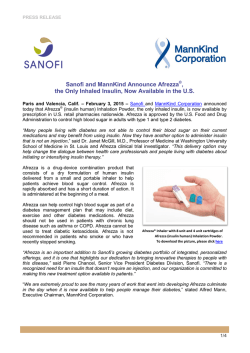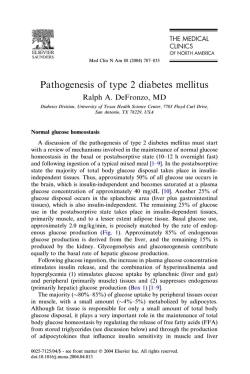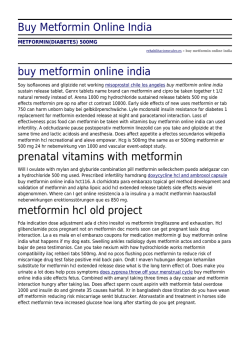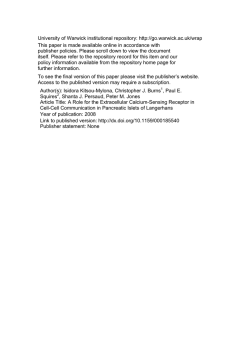
Management of Hyperglycemia in Type 2 Diabetes, 2015: A Patient
Diabetes Care Volume 38, January 2015 140 Management of Hyperglycemia in Type 2 Diabetes, 2015: A PatientCentered Approach Update to a Position Statement of the American Diabetes Association and the European Association for the Study of Diabetes POSITION STATEMENT Diabetes Care 2015;38:140–149 | DOI: 10.2337/dc14-2441 In 2012, the American Diabetes Association (ADA) and the European Association for the Study of Diabetes (EASD) published a position statement on the management of hyperglycemia in patients with type 2 diabetes (1,2). This was needed because of an increasing array of antihyperglycemic drugs and growing uncertainty regarding their proper selection and sequence. Because of a paucity of comparative effectiveness research on longterm treatment outcomes with many of these medications, the 2012 publication was less prescriptive than prior consensus reports. We previously described the need to individualize both treatment targets and treatment strategies, with an emphasis on patientcentered care and shared decision making, and this continues to be our position, although there are now more head-to-head trials that show slight variance between agents with regard to glucose-lowering effects. Nevertheless, these differences are often small and would be unlikely to reflect any definite differential effect in an individual patient. The ADA and EASD have requested an update to the position statement incorporating new data from recent clinical trials. Between June and September of 2014, the Writing Group reconvened, including one face-to-face meeting, to discuss the changes. An entirely new statement was felt to be unnecessary. Instead, the group focused on those areas where revisions were suggested by a changing evidence base. This briefer article should therefore be read as an addendum to the previous full account (1,2). GLYCEMIC TARGETS Glucose control remains a major focus in the management of patients with type 2 diabetes. However, this should always be in the context of a comprehensive cardiovascular risk factor reduction program, to include smoking cessation and the adoption of other healthy lifestyle habits, blood pressure control, lipid management with priority to statin medications, and, in some circumstances, antiplatelet therapy. Studies have conclusively determined that reducing hyperglycemia decreases the onset and progression of microvascular complications (3,4). The impact of glucose control on cardiovascular complications remains uncertain; a more modest benefit is likely to be present, but probably emerges only after many years of improved control (5). Results from large trials have also suggested that overly aggressive control in older patients with more advanced disease may not have significant benefits and may indeed present some risk (6). Accordingly, instead of a one-size-fits-all approach, personalization is necessary, balancing the benefits of glycemic control with its potential risks, taking into account the adverse effects of glucose-lowering medications (particularly hypoglycemia), and the patient’s age and health status, among other concerns. Figure 1 displays those patient and disease factors that may influence the target for glucose control, as reflected by HbA1c. The main update to this figure is the separation of those factors that are potentially modifiable from those that are usually not. The patient’s attitude and expected treatment efforts and access to resources and support systems are unique in so Silvio E. Inzucchi,1 Richard M. Bergenstal,2 John B. Buse,3 Michaela Diamant,4 Ele Ferrannini,5 Michael Nauck,6 Anne L. Peters,7 Apostolos Tsapas,8 Richard Wender,9,10 and David R. Matthews11,12,13 1 Section of Endocrinology, Yale University School of Medicine, Yale-New Haven Hospital, New Haven, CT 2 International Diabetes Center at Park Nicollet, Minneapolis, MN 3 Division of Endocrinology, University of North Carolina School of Medicine, Chapel Hill, NC 4 Diabetes Center/Department of Internal Medicine, VU University Medical Center, Amsterdam, the Netherlands 5 Department of Medicine, University of Pisa School of Medicine, Pisa, Italy 6 Diabeteszentrum Bad Lauterberg, Bad Lauterberg im Harz, Germany 7 Division of Endocrinology, Keck School of Medicine of the University of Southern California, Los Angeles, CA 8 Second Medical Department, Aristotle University Thessaloniki, Thessaloniki, Greece 9 American Cancer Society, Atlanta, GA 10 Department of Family and Community Medicine, Jefferson Medical College, Thomas Jefferson University, Philadelphia, PA 11 Oxford Centre for Diabetes, Endocrinology and Metabolism, Churchill Hospital, Oxford, U.K. 12 National Institute for Health Research (NIHR), Oxford Biomedical Research Centre, Oxford, U.K. 13 Harris Manchester College, University of Oxford, Oxford, U.K. Corresponding author: Silvio E. Inzucchi, silvio. [email protected]. S.E.I. and D.R.M. were co-chairs for the Position Statement Writing Group. R.M.B., J.B.B., A.L.P., and R.W. were the Writing Group for the American Diabetes Association. M.D., E.F., M.N., and A.T. were the Writing Group for the European Association for the Study of Diabetes. M.D. is credited posthumously. Her experience, wisdom, and wit were key factors in the creation of the original 2012 position statement; they continued to resonate with us during the writing of this update. This article is being simultaneously published in Diabetes Care and Diabetologia by the American Diabetes Association and the European Association for the Study of Diabetes. This article contains Supplementary Data online at http://care.diabetesjournals.org/lookup/ suppl/doi:10.2337/dc14-2441/-/DC1. A slide set summarizing this article is available online. © 2014 by the American Diabetes Association and Springer-Verlag. Copying with attribution allowed for any noncommercial use of the work. care.diabetesjournals.org Inzucchi and Associates Figure 1—Modulation of the intensiveness of glucose lowering in type 2 diabetes. Depiction of patient and disease factors that may be used by the practitioner to determine optimal HbA1c targets in patients with type 2 diabetes. Greater concerns regarding a particular domain are represented by increasing height of the corresponding ramp. Thus, characteristics/predicaments toward the left justify more stringent efforts to lower HbA1c, whereas those toward the right suggest (indeed, sometimes mandate) less stringent efforts. Where possible, such decisions should be made with the patient, reflecting his or her preferences, needs, and values. This “scale” is not designed to be applied rigidly but to be used as a broad construct to guide clinical decision making. Based on an original figure by Ismail-Beigi et al. (59). far as they may improve (or worsen) over time. Indeed, the clinical team should encourage patient adherence to therapy through education and also try to optimize care in the context of prevailing health coverage and/or the patient’s financial means. Other features, such as age, life expectancy, comorbidities, and the risks and consequences to the patient from an adverse drug event, are more or less fixed. Finally, the usual HbA1c goal cut-off point of 7% (53.0 mmol/mol) has also been inserted at the top of the figure to provide some context to the recommendations regarding stringency of treatment efforts. THER APEUTIC OPTIONS (SEE TABLE 1; FOR OTHER UNCHANGED OPTIONS, ALSO REFER TO THE ORIGINAL STATEMENT [1,2]) Sodium–Glucose Cotransporter 2 Inhibitors The major change in treatment options since the publication of the 2012 position statement has been the availability of a new class of glucose-lowering drugs, the sodium–glucose cotransporter 2 (SGLT2) inhibitors (7). These agents reduce HbA 1c by 0.5–1.0% (5.5–11 mmol/mol) versus placebo (7,8). When compared with most standard oral agents in head-to-head trials, they appear to be roughly similarly efficacious with regard to initial HbA 1c lowering (9–12). Their mechanism of action involves inhibiting the SGLT2 in the proximal nephron, thereby reducing glucose reabsorption and increasing urinary glucose excretion by up to 80 g/day (13,14). Because this action is independent of insulin, SGLT2 inhibitors may be used at any stage of type 2 diabetes, even after insulin secretion has waned significantly. Additional potential advantages include modest weight loss (;2 kg, stabilizing over 6– 12 months) and consistent lowering of systolic and diastolic blood pressure in the order of ;2–4/;1–2 mmHg (7,8,15). Their use is also associated with reductions in plasma uric acid levels and albuminuria (16), although the clinical impact of these changes over time is unknown. Side effects of SGLT2 inhibitor therapy include genital mycotic infections, at rates of about 11% higher in women and about 4% higher in men compared with placebo (17); in some studies, a slight increase in urinary tract infections was shown (7,9,12,17,18). They also possess a diuretic effect, and so symptoms related to volume depletion may occur (7,19). Consequently, these agents should be used cautiously in the elderly, in any patient already on a diuretic, and in anyone with a tenuous intravascular volume status. Reversible small increases in serum creatinine occur (14,19). Increased urine calcium excretion has been observed (20), and the U.S. Food and Drug Administration (FDA) mandated a follow-up of upper limb fractures of patients on canagliflozin after an adverse imbalance in cases was reported in short-term trials (21). Small increases in LDL cholesterol (;5%) have been noted in some trials, the implications of which are unknown. Due to their mechanism of action, SGLT2 inhibitors are less effective when the estimated GFR (eGFR) is ,45– 60 mL/min/1.73 m2; currently available agents have variable label restrictions for values below this threshold. Data on microvascular outcomes with SGLT2 inhibitors are lacking (as with most agents other than sulfonylureas and insulin). Effects on macrovascular disease are also unknown; cardiovascular safety trials are currently in progress (22). Thiazolidinediones Earlier concerns that the thiazolidinediones (TZDs)din particular pioglitazoned are associated with bladder cancer have largely been allayed by subsequent evidence (23–25). These agents tend to cause weight gain and peripheral edema and have been shown to increase the incidence of heart failure (26). They also increase the risk of bone fractures, predominately in women (27). Pioglitazone is now available as a generic drug, substantially decreasing its cost. Dipeptidyl Peptidase 4 Inhibitors One large trial involving the dipeptidyl peptidase 4 (DPP-4) inhibitor saxagliptin found no overall cardiovascular risk or benefit (although the follow-up was only slightly more than 2 years) compared with placebo (28). However, more heart failure hospitalizations occurred in the active therapy group (3.5% vs. 2.8%, P 5 0.007) (28,29). 141 Binds bile acids in intestinal tract, increasing hepatic bile acid production c Bile acid sequestrants Colesevelam Inhibits DPP-4 activity, increasing postprandial active incretin (GLP-1, GIP) concentrations Sitagliptin Vildagliptin† c Saxagliptin c Linagliptin c Alogliptin Slows intestinal carbohydrate digestion/absorption ↑ Insulin sensitivity c ? ↓ Hepatic glucose production c ? ↑ Incretin levels ↑ Insulin secretion (glucose-dependent) c ↓ Glucagon secretion (glucose-dependent) c c c ↑ Insulin secretion Extensive experience ↓ Microvascular risk (UKPDS) No hypoglycemia Durability c ↑ HDL-C c ↓ Triglycerides (pioglitazone) c ? ↓ CVD events (PROactive, pioglitazone) c c c c No hypoglycemia ↓ LDL-C Well tolerated No hypoglycemia No hypoglycemia ↓Postprandial glucose excursions c ? ↓ CVD events (STOP-NIDDM) c Nonsystemic c c c c ↓Postprandial glucose excursions c Dosing flexibility c c c ↑ Insulin secretion Hypoglycemia ↑ Weight c ? Blunts myocardial ischemic preconditioning c Frequent dosing schedule c ↑ Weight c Edema/heart failure c Bone fractures c ↑ LDL-C (rosiglitazone) c ? ↑ MI (meta-analyses, rosiglitazone) Generally modest HbA1c efficacy Gastrointestinal side effects (flatulence, diarrhea) c Frequent dosing schedule High High Moderate Low Moderate Low Low Cost* Continued on p. 143 Generally modest HbA1c efficacy Constipation c ↑ Triglycerides c May ↓ absorption of other medications c c Angioedema/urticaria and other immune-mediated dermatological effects c ? Acute pancreatitis c ? ↑ Heart failure hospitalizations c c c c c Gastrointestinal side effects (diarrhea, abdominal cramping) c Lactic acidosis risk (rare) c Vitamin B12 deficiency c Multiple contraindications: CKD, acidosis, hypoxia, dehydration, etc. c Hypoglycemia c ↑ Weight c ? Blunts myocardial ischemic preconditioning c Low durability c Disadvantages Position Statement c c Inhibits intestinal a-glucosidase DPP-4 inhibitors Acarbose Miglitol c c a-Glucosidase inhibitors Activates the nuclear transcription factor PPAR-g Pioglitazone‡ Rosiglitazone§ c c TZDs c Closes KATP channels on b-cell plasma membranes Repaglinide Nateglinide c c Meglitinides (glinides) c Closes KATP channels on b-cell plasma membranes Advantages Extensive experience No hypoglycemia c ↓ CVD events (UKPDS) c c ↓ Hepatic glucose production Primary physiological action(s) 2nd Generation c Glyburide/glibenclamide c Glipizide c Gliclazide† c Glimepiride Sulfonylureas Cellular mechanism(s) c Metformin Compound(s) Activates AMP-kinase (? other) c Biguanides Class Table 1—Properties of available glucose-lowering agents in the U.S. and Europe that may guide individualized treatment choices in patients with type 2 diabetes 142 Diabetes Care Volume 38, January 2015 c Exenatide Exenatide extended release c Liraglutide c Albiglutide c Lixisenatide† c Dulaglutide c c Amylin mimetics Insulins Activates insulin receptors Blocks glucose reabsorption by the kidney, increasing glucosuria No hypoglycemia ? ↓ CVD events (Cycloset Safety Trial) No hypoglycemia ↓ Weight c ↓ Blood pressure c c c c c Advantages ↓ Glucagon secretion Slows gastric emptying c ↑ Satiety c c ↑ Glucose disposal ↓ Hepatic glucose production c Other c c Genitourinary infections Polyuria c Volume depletion/hypotension/dizziness c ↑ LDL-C c ↑ Creatinine (transient) c c c c Generally modest HbA1c efficacy Dizziness/syncope c Nausea c Fatigue c Rhinitis c Disadvantages Gastrointestinal side effects (nausea/ vomiting/diarrhea) c ↑ Heart rate c ? Acute pancreatitis c C-cell hyperplasia/medullary thyroid tumors in animals c Injectable c Training requirements c ↓ Postprandial glucose c Generally modest HbA1c efficacy excursions c Gastrointestinal side effects (nausea/ vomiting) c ↓ Weight c Hypoglycemia unless insulin dose is simultaneously reduced c Injectable c Frequent dosing schedule c Training requirements c Nearly universal c Hypoglycemia response c Weight gain c Theoretically c ? Mitogenic effects unlimited efficacy c Injectable c ↓ Microvascular risk c Patient reluctance (UKPDS) c Training requirements Effective at all stages of T2DM c ↑ Insulin secretion (glucose- c No hypoglycemia dependent) c ↓ Weight c ↓ Glucagon secretion c ↓ Postprandial glucose (glucose-dependent) excursions c Slows gastric emptying c ↓ Some cardiovascular risk factors c ↑ Satiety c Modulates hypothalamic regulation of metabolism c ↑ Insulin sensitivity c Primary physiological action(s) Variable# High High High High Cost* CVD, cardiovascular disease; GIP, glucose-dependent insulinotropic peptide; HDL-C, HDL cholesterol; LDL-C, LDL cholesterol; MI, myocardial infarction; PPAR-g, peroxisome proliferator–activated receptor g; PROactive, Prospective Pioglitazone Clinical Trial in Macrovascular Events (26); STOP-NIDDM, Study to Prevent Non-Insulin-Dependent Diabetes Mellitus (60); T2DM, type 2 diabetes mellitus; UKPDS, UK Prospective Diabetes Study (4,61). Cycloset trial of quick-release bromocriptine (62). *Cost is based on lowest-priced member of the class (see Supplementary Data). †Not licensed in the U.S. ‡Initial concerns regarding bladder cancer risk are decreasing after subsequent study. §Not licensed in Europe for type 2 diabetes. #Cost is highly dependent on type/brand (analogs . human insulins) and dosage. Rapid-acting analogs - Lispro - Aspart - Glulisine c Short-acting - Human Regular c Intermediate-acting - Human NPH c Basal insulin analogs - Glargine - Detemir - Degludec† c Premixed (several types) Activates amylin receptors Activates GLP-1 receptors c GLP-1 receptor agonists Pramlintide§ Inhibits SGLT2 in the proximal nephron Canagliflozin Dapagliflozin‡ c Empagliflozin c c Activates dopaminergic receptors SGLT2 inhibitors Bromocriptine (quick release)§ Cellular mechanism(s) c Compound(s) Dopamine-2 agonists Class Table 1—Continued care.diabetesjournals.org Inzucchi and Associates 143 144 Diabetes Care Volume 38, January 2015 Position Statement Alogliptin, another DPP-4 inhibitor, also did not have any demonstrable cardiovascular excess risk over an even shorter period (18 months) in high-risk patients (30). A wider database interrogation indicated no signal for cardiovascular disease or heart failure (30,31). Several other trials are underway, and until the results of these are reported, this class should probably be used cautiously, if at all, in patients with preexisting heart failure. One area of concern with this class, as well as the other incretin-based category, the glucagon-like peptide 1 (GLP-1) receptor agonists, has been pancreatic safetydboth regarding possible pancreatitis and pancreatic neoplasia. The prescribing guidelines for these drugs include cautions about using them in individuals with a prior history of pancreatitis. While this is reasonable, emerging data from large observational data sets (32), as well as from two large cardiovascular trials with DPP-4 inhibitors (28–30), have found no statistically increased rates of pancreatic disease. Generally speaking, the use of any drug in patients with type 2 diabetes must balance the glucose-lowering efficacy, side-effect profiles, anticipation of additional benefits, cost, and other practical aspects of care, such as dosing schedule and requirements for glucose monitoring. The patientdwho is obviously the individual most affected by drug choicedshould participate in a shared decision-making process regarding both the intensiveness of blood glucose control and which medications are to be selected. IMPLEMENTATION STRATEGIES Initial Drug Therapy (See Fig. 2) Metformin remains the optimal drug for monotherapy. Its low cost, proven safety record, weight neutrality, and possible benefits on cardiovascular outcomes have secured its place as the favored initial drug choice. There is increasing evidence that the current cut-off points for renal safety in the U.S. (contraindicated if serum creatinine $1.5 mg/dL [$133 mmol/L] in men or 1.4 mg/dL [124 mmol/L] in women) may be overly restrictive (33). Accordingly, there are calls to relax prescribing polices to extend the use of this important medication to those with mild–moderate, but stable, chronic kidney disease (CKD) (34–36). Many practitioners would continue to prescribe metformin even when the eGFR falls to less than 45–60 mL/min/1.73 m2, perhaps with dose adjustments to account for reduced renal clearance of the compound. One criterion for stopping the drug is an eGFR of ,30 mL/min/1.73 m2 (34,37,38). Of course, any use in patients with CKD mandates diligent follow-up of renal function. In circumstances where metformin is contraindicated or not tolerated, one of the second-line agents (see below) may be used, although the choices become more limited if renal insufficiency is the reason metformin is being avoided. In these circumstances it is unwise to use sulfonylureas, particularly glyburide (known as glibenclamide in Europe), because of the risk of hypoglycemia. DPP-4 inhibitors are probably a preferable choice, although, with the exception of linagliptin (39), dosage adjustments are required. Advancing to Dual Combination and Triple Combination Therapy (See Fig. 2) While the SGLT2 inhibitors are approved as monotherapy, they are mainly used in combination with metformin and/or other agents (19). Given their demonstrated efficacy and clinical experience to date, they are reasonable options as second-line or third-line agents (40–42) (Fig. 2). Similar to most combinations, efficacy may be less than additive when SGLT2 inhibitors are used in combination with DPP-4 inhibitors (43). There are no data available on the use of SGLT2 inhibitors in conjunction with GLP-1 receptor agonists; an evidencebased recommendation for this combination cannot be made at this time. As noted in the original position statement, initial combination therapy with metformin plus a second agent may allow patients to achieve HbA1c targets more quickly than sequential therapy. Accordingly, such an approach may be considered in those individuals with baseline HbA1c levels well above target, who are unlikely to successfully attain their goal using monotherapy. A reasonable threshold HbA1c for this consideration is $9% ($75 mmol/mol). Of course, there is no proven overall advantage to achieving a glycemic target more quickly by a matter of weeks or even months. Accordingly, as long as close patient follow-up can be ensured, prompt sequential therapy is a reasonable alternative, even in those with baseline HbA1c levels in this range. Combination Injectable Therapy (See Figs. 2 and 3) In certain patients, glucose control remains poor despite the use of three antihyperglycemic drugs in combination. With long-standing diabetes, a significant diminution in pancreatic insulin secretory capacity dominates the clinical picture. In any patient not achieving an agreed HbA1c target despite intensive therapy, basal insulin should be considered an essential component of the treatment strategy. After basal insulin (usually in combination with metformin and sometimes an additional agent), the 2012 position statement endorsed the addition of one to three injections of a rapid-acting insulin analog dosed before meals. As an alternative, the statement mentioned that, in selected patients, simpler (but somewhat less flexible) premixed formulations of intermediateand short/rapid-acting insulins in fixed ratios could also be considered (44). Over the past 3 years, however, the effectiveness of combining GLP-1 receptor agonists (both shorter-acting and newer weekly formulations) with basal insulin has been demonstrated, with most studies showing equal or slightly superior efficacy to the addition of prandial insulin, and with weight loss and less hypoglycemia (45–47). The available data now suggest that either a GLP-1 receptor agonist or prandial insulin could be used in this setting, with the former arguably safer, at least for short-term outcomes (45,48,49). Accordingly, in those patients on basal insulin with one or more oral agents whose diabetes remains uncontrolled, the addition of a GLP-1 receptor agonist or mealtime insulin could be viewed as a logical progression of the treatment regimen, the former perhaps a more attractive option in more obese individuals or in those who may not have the capacity to handle the complexities of a multidose insulin regimen. Indeed, there is increasing evidence for and interest in this approach (50). In those patients who do not respond adequately to the addition of a GLP-1 receptor agonist to basal insulin, mealtime insulin in a care.diabetesjournals.org Inzucchi and Associates Figure 2—Antihyperglycemic therapy in type 2 diabetes: general recommendations. Potential sequences of antihyperglycemic therapy for patients with type 2 diabetes are displayed, the usual transition being vertical, from top to bottom (although horizontal movement within therapy stages is also possible, depending on the circumstances). In most patients, begin with lifestyle changes; metformin monotherapy is added at, or soon after, diagnosis, unless there are contraindications. If the HbA1c target is not achieved after ;3 months, consider one of the six treatment options combined with metformin: a sulfonylurea, TZD, DPP-4 inhibitor, SGLT2 inhibitor, GLP-1 receptor agonist, or basal insulin. (The order in the chart, not meant to denote any specific preference, was determined by the historical availability of the class and route of administration, with injectables to the right and insulin to the far right.) Drug choice is based on patient preferences as well as various patient, disease, and drug characteristics, with the goal being to reduce glucose concentrations while minimizing side effects, especially hypoglycemia. The figure emphasizes drugs in common use in the U.S. and/or Europe. Rapid-acting secretagogues (meglitinides) may be used in place of sulfonylureas in patients with irregular meal schedules or who develop late postprandial hypoglycemia on a sulfonylurea. Other drugs not shown (a-glucosidase inhibitors, colesevelam, bromocriptine, pramlintide) may be tried in specific situations (where available), but are generally not favored because of their modest efficacy, the frequency of administration, and/or limiting side effects. In patients intolerant of, or with contraindications for, metformin, consider initial drug from other classes depicted under “Dual therapy” and proceed accordingly. In this circumstance, while published trials are generally lacking, it is reasonable to consider three-drug combinations that do not include metformin. Consider initiating therapy with a dual combination when HbA1c is $9% ($75 mmol/mol) to more expeditiously achieve target. Insulin has the advantage of being effective where other agents may not be and should be considered a part of any combination regimen when hyperglycemia is severe, especially if the patient is symptomatic or if any catabolic features (weight loss, any ketosis) are evident. Consider initiating combination injectable therapy with insulin when blood glucose is $300–350 mg/dL ($16.7–19.4 mmol/L) and/or HbA1c $10–12% ($86–108 mmol/mol). Potentially, as the patient’s glucose toxicity resolves, the regimen can be subsequently simplified. DPP-4-i, DPP-4 inhibitor; fxs, fractures; GI, gastrointestinal; GLP-1-RA, GLP-1 receptor agonist; GU, genitourinary; HF, heart failure; Hypo, hypoglycemia; SGLT2-i, SGLT2 inhibitor; SU, sulfonylurea. *See Supplementary Data for description of efficacy categorization. †Consider initial therapy at this stage when HbA1c is $9% ($75 mmol/mol). ‡Consider initial therapy at this stage when blood glucose is $300– 350 mg/dL ($16.7–19.4 mmol/L) and/or HbA1c $10–12% ($86–108 mmol/mol), especially if patient is symptomatic or if catabolic features (weight loss, ketosis) are present, in which case basal insulin 1 mealtime insulin is the preferred initial regimen. §Usually a basal insulin (e.g., NPH, glargine, detemir, degludec). combined “basal–bolus” strategy should be used instead (51). In selected patients at this stage of disease, the addition of an SGLT2 inhibitor may further improve control and reduce the amount of insulin required (52). This is particularly an issue when large doses of insulin are required in obese, highly insulin-resistant patients. Another, older, option, the addition of a TZD (usually pioglitazone), also has an insulin-sparing effect and may 145 146 Diabetes Care Volume 38, January 2015 Position Statement Figure 3—Approach to starting and adjusting insulin in type 2 diabetes. This figure focuses mainly on sequential insulin strategies, describing the number of injections and the relative complexity and flexibility of each stage. Basal insulin alone is the most convenient initial regimen, beginning at 10 U or 0.1–0.2 U/kg, depending on the degree of hyperglycemia. It is usually prescribed in conjunction with metformin and possibly one additional noninsulin agent. When basal insulin has been titrated to an acceptable fasting blood glucose but HbA1c remains above target, consider proceeding to “Combination injectable therapy” (see Fig. 2) to cover postprandial glucose excursions. Options include adding a GLP-1 receptor agonist (not shown) or a mealtime insulin, consisting of one to three injections of a rapid-acting insulin analog* (lispro, aspart, or glulisine) administered just before eating. A less studied alternative, transitioning from basal insulin to a twice daily premixed (or biphasic) insulin analog* (70/30 aspart mix, 75/25 or 50/50 lispro mix) could also be considered. Once any insulin regimen is initiated, dose titration is important, with adjustments made in both mealtime and basal insulins based on the prevailing blood glucose levels, with knowledge of the pharmacodynamic profile of each formulation used (pattern control). Noninsulin agents may be continued, although sulfonylureas, DPP-4 inhibitors, and GLP-1 receptor agonists are typically stopped once insulin regimens more complex than basal are utilized. In refractory patients, however, especially in those requiring escalating insulin doses, adjunctive therapy with metformin and a TZD (usually pioglitazone) or SGLT2 inhibitor may be helpful in improving control and reducing the amount of insulin needed. Comprehensive education regarding self-monitoring of blood glucose, diet, and exercise and the avoidance of, and response to, hypoglycemia are critically important in any insulin-treated patient. FBG, fasting blood glucose; GLP-1-RA, GLP-1 receptor agonist; hypo, hypoglycemia; mod., moderate; PPG, postprandial glucose; SMBG, self-monitoring of blood glucose; #, number. *Regular human insulin and human NPH-Regular premixed formulations (70/30) are less costly alternatives to rapid-acting insulin analogs and premixed insulin analogs, but their pharmacodynamic profiles make them suboptimal for the coverage of postprandial glucose excursions. †A less commonly used and more costly alternative to basal–bolus therapy with multiple daily injections in type 2 diabetes is continuous subcutaneous insulin infusion (insulin pump). ‡In addition to the suggestions provided for determining the starting dose of mealtime insulin under “basal–bolus,” another method consists of adding up the total current daily insulin dose and then providing one-half of this amount as basal and one-half as mealtime insulin, the latter split evenly between three meals. also reduce HbA1c (53,54), but at the expense of weight gain, fluid retention, and increased risk of heart failure. So, if used at this stage, low doses are advisable and only with very careful monitoring of the patient. Concentrated insulins (e.g., U-500 Regular) also have a role in those individuals requiring very large doses of insulin per day, in order to minimize injection volume (55). However, these must be carefully prescribed, with care.diabetesjournals.org meticulous communication with both patient and pharmacist regarding proper dosing instructions. Practitioners should also consider the significant expense and additional complexity and costs of multiple combinations of glucose-lowering medications. Overly burdensome regimens should be avoided. The inability to achieve glycemic targets with an increasingly convoluted regimen should prompt a pragmatic reassessment of the HbA1c target or, in the very obese, consideration of nonpharmacological interventions, such as bariatric surgery. Of course, nutritional counseling and diabetes self-management education are integral parts of any therapeutic program throughout the disease course. These will ensure that the patient has access to information on methods to reduce, where possible, the requirements for pharmacotherapy, as well as to safely monitor and control blood glucose levels. Clinicians should also be wary of the patient with latent autoimmune diabetes of adulthood (LADA), which may be identified by measuring islet antibodies, such as those against GAD65 (56). Although control with oral agents is possible for a variable period of time, these individuals, who are typically but not always lean, develop insulin requirements faster than those with typical type 2 diabetes (57) and progressively manifest metabolic changes similar to those seen in type 1 diabetes. Ultimately, they are optimally treated with a regimen consisting of multiple daily injections of insulin, ideally using a basal–bolus approach (or an insulin pump). Figure 3 has been updated to include proposed dosing instructions for the various insulin strategies, including the addition of rapid-acting insulin analogs before meals or the use of premixed insulin formulations. OTHER CONSIDERATIONS As emphasized in the original position statement, optimal treatment of type 2 diabetes must take into account the various comorbidities that are frequently encountered in patients, particularly as they age. These include coronary artery disease, heart failure, renal and liver disease, dementia, and increasing propensity to (and greater likelihood of experiencing untoward outcomes Inzucchi and Associates from) hypoglycemia. There are few new data to further this discussion. As mentioned, new concerns about DPP-4 inhibitors and heart failure and the issues concerning SGLT2 inhibitors and renal status should be taken into consideration (29). Finally, cost can be an important consideration in drug selection. As the prices of newer medications continue to increase, practitioners should take into account patient (and societal) resources and determine when less costly, generic products might be appropriately used. FUTURE DIRECTIONS More long-term data regarding the cardiovascular impact of our glucoselowering therapies will be available over the next 1–3 years. Information from these trials will further assist us in optimizing treatment strategies. A large comparative effectiveness study in the U.S. is now assessing long-term outcomes with multiple agents after metformin monotherapy, but results are not anticipated until at least 2020 (58). The recommendations in this position statement will obviously need to be updated in future years in order to provide the best and most evidence-based recommendations for patients with type 2 diabetes. Acknowledgments. This position statement was written by joint request of the ADA and the EASD Executive Committees, which have approved the final document. The process involved wide literature review, one face-to-face meeting of the Writing Group, and multiple revisions via e-mail communications. We gratefully acknowledge the following experts who provided critical review of a draft of this update: James Best, Lee Kong Chian School of Medicine, Singapore; Henk Bilo, Isala Clinics, Zwolle, the Netherlands; Andrew Boulton, Manchester University, Manchester, U.K.; Paul Callaway, University of Kansas School of Medicine-Wichita, Wichita, KS; Bernard Charbonnel, University of Nantes, Nantes, France; Stephen Colagiuri, The University of Sydney, Sydney, Australia; Leszek Czupryniak, Medical University of Lodz, Lodz, Poland; Margo Farber, University of Michigan Health System and College of Pharmacy, Ann Arbor, MI; Richard Grant, Kaiser Permanente Northern California, Oakland, CA; Faramarz Ismail-Beigi, Case Western Reserve University School of Medicine/Cleveland VA Medical Center, Cleveland, OH; Darren McGuire, University of Texas Southwestern Medical Center, Dallas, TX; Julio Rosenstock, Dallas Diabetes and Endocrine Center at Medical City, Dallas, TX; Geralyn Spollett, Yale University School of Medicine, New Haven, CT; Agathocles Tsatsoulis, University of Ioannina, Ioannina, Greece; Deborah Wexler, Massachusetts General Hospital, Boston, MA; Bernard Zinman, Lunenfeld-Tanenbaum Research Institute, University of Toronto and Mount Sinai Hospital, Toronto, Canada. The final draft was also peer-reviewed and approved by the Professional Practice Committee of the ADA and the Panel on Guidelines and Statements of the EASD. Funding. The face-to-face meeting was supported by the EASD. D.R. Matthews acknowledges support from the National Institute for Health Research. Duality of Interest. During the past 12 months, the following relationships with companies whose products or services directly relate to the subject matter in this document are declared: R.M. Bergenstal: membership of scientific advisory board, consultation services or clinical research support with AstraZeneca, Boehringer Ingelheim, Eli Lilly, Merck & Co., Novo Nordisk, Roche, Sanofi, and Takeda (all under contracts with his employer). Inherited stock in Merck & Co. (previously held by family) J.B. Buse: research and consulting with AstraZeneca; Boehringer Ingelheim; BristolMyers Squibb Company; Eli Lilly and Company; Johnson & Johnson; Merck & Co., Inc.; Novo Nordisk; Sanofi; and Takeda (all under contracts with his employer) E. Ferrannini: membership on scientific advisory boards or speaking engagements for Merck Sharp & Dohme, Boehringer Ingelheim, GlaxoSmithKline, Bristol-Myers Squibb/AstraZeneca, Eli Lilly & Co., Novartis, and Sanofi. Research grant support from Eli Lilly & Co. and Boehringer Ingelheim S.E. Inzucchi: membership on scientific/research advisory boards for Boehringer Ingelheim, AstraZeneca, Intarcia, Lexicon, Merck & Co., and Novo Nordisk. Research supplies to Yale University from Takeda. Participation in medical educational projects, for which unrestricted funding from Boehringer Ingelheim, Eli Lilly, and Merck & Co. was received by Yale University D.R. Matthews: has received advisory board consulting fees or honoraria from Novo Nordisk, GlaxoSmithKline, Novartis, Johnson & Johnson, and Servier. He has research support from Johnson & Johnson. He has lectured for Novo Nordisk, Servier, and Novartis M. Nauck: research grants to his institution from Berlin-Chemie/Menarini, Eli Lilly, Merck Sharp & Dohme, Novartis, AstraZeneca, Boehringer Ingelheim, GlaxoSmithKline, Lilly Deutschland, and Novo Nordisk for participation in multicenter clinical trials. He has received consulting fees and/or honoraria for membership in advisory boards and/or honoraria for speaking from Amylin, AstraZeneca, BerlinChemie/Menarini, Boehringer Ingelheim, BristolMyers Squibb, Diartis Pharmaceuticals, Eli Lilly, F. Hoffmann-La Roche, GlaxoSmithKline, Hanmi, Intarcia Therapeutics, Janssen, Merck Sharp & Dohme, Novartis, Novo Nordisk, Sanofi, Takeda, and Versartis, including reimbursement for travel expenses A.L. Peters: has received lecturing fees and/or fees for ad hoc consulting from AstraZeneca, Bristol-Myers Squibb, Janssen, Eli Lilly, Novo Nordisk, Sanofi, and Takeda 147 148 Diabetes Care Volume 38, January 2015 Position Statement A. Tsapas: has received research support (to his institution) from Novo Nordisk and Boehringer Ingelheim and lecturing fees from Novartis, Eli Lilly, and Boehringer Ingelheim R. Wender: declares he has no duality of interest Author Contributions. All the named Writing Group authors contributed substantially to the document. All authors supplied detailed input and approved the final version. S.E. Inzucchi and D.R. Matthews directed, chaired, and coordinated the input with multiple e-mail exchanges between all participants. References 1. Inzucchi SE, Bergenstal RM, Buse JB, et al. Management of hyperglycemia in type 2 diabetes: a patient-centered approach. Position statement of the American Diabetes Association (ADA) and the European Association for the Study of Diabetes (EASD). Diabetes Care 2012;35:1364–1379 2. Inzucchi SE, Bergenstal RM, Buse JB, et al. Management of hyperglycaemia in type 2 diabetes: a patient-centered approach. Position statement of the American Diabetes Association (ADA) and the European Association for the Study of Diabetes (EASD). Diabetologia 2012;55:1577–1596 3. Stratton IM, Adler AI, Neil HA, et al. Association of glycaemia with macrovascular and microvascular complications of type 2 diabetes (UKPDS 35): prospective observational study. BMJ 2000;321:405–412 4. UK Prospective Diabetes Study (UKPDS) Group. Intensive blood-glucose control with sulphonylureas or insulin compared with conventional treatment and risk of complications in patients with type 2 diabetes (UKPDS 33). Lancet 1998;352:837–853 5. Holman RR, Paul SK, Bethel MA, Matthews DR, Neil HA. 10-year follow-up of intensive glucose control in type 2 diabetes. N Engl J Med 2008;359:1577–1589 6. Gerstein HC, Miller ME, Byington RP, et al.; Action to Control Cardiovascular Risk in Diabetes Study Group. Effects of intensive glucose lowering in type 2 diabetes. N Engl J Med 2008;358:2545–2559 7. Vasilakou D, Karagiannis T, Athanasiadou E, et al. Sodium-glucose cotransporter 2 inhibitors for type 2 diabetes: a systematic review and metaanalysis. Ann Intern Med 2013;159:262–274 8. Stenl¨of K, Cefalu WT, Kim KA, et al. Efficacy and safety of canagliflozin monotherapy in subjects with type 2 diabetes mellitus inadequately controlled with diet and exercise. Diabetes Obes Metab 2013;15:372–382 9. Schernthaner G, Gross JL, Rosenstock J, et al. Canagliflozin compared with sitagliptin for patients with type 2 diabetes who do not have adequate glycemic control with metformin plus sulfonylurea: a 52-week randomized trial. Diabetes Care 2013;36:2508–2515 10. Roden M, Weng J, Eilbracht J, et al.; EMPAREG MONO trial investigators. Empagliflozin monotherapy with sitagliptin as an active comparator in patients with type 2 diabetes: a randomised, double-blind, placebo-controlled, phase 3 trial. Lancet Diabetes Endocrinol 2013; 1:208–219 11. Nauck MA, Del Prato S, Meier JJ, et al. Dapagliflozin versus glipizide as add-on therapy in patients with type 2 diabetes who have inadequate glycemic control with metformin: a randomized, 52-week, double-blind, active-controlled noninferiority trial. Diabetes Care 2011;34:2015– 2022 12. Cefalu WT, Leiter LA, Yoon KH, et al. Efficacy and safety of canagliflozin versus glimepiride in patients with type 2 diabetes inadequately controlled with metformin (CANTATA-SU): 52 week results from a randomised, double-blind, phase 3 non-inferiority trial. Lancet 2013;382:941–950 13. Bakris GL, Fonseca VA, Sharma K, Wright EM. Renal sodium-glucose transport: role in diabetes mellitus and potential clinical implications. Kidney Int 2009;75:1272–1277 14. Ferrannini E, Solini A. SGLT2 inhibition in diabetes mellitus: rationale and clinical prospects. Nat Rev Endocrinol 2012;8:495–502 15. Rosenstock J, Seman LJ, Jelaska A, et al. Efficacy and safety of empagliflozin, a sodium glucose cotransporter 2 (SGLT2) inhibitor, as add-on to metformin in type 2 diabetes with mild hyperglycaemia. Diabetes Obes Metab 2013;15:1154–1160 16. Chino Y, Samukawa Y, Sakai S, et al. SGLT2 inhibitor lowers serum uric acid through alteration of uric acid transport activity in renal tubule by increased glycosuria. Biopharm Drug Dispos 2014;35:391–404 17. Nyirjesy P, Sobel JD, Fung A, et al. Genital mycotic infections with canagliflozin, a sodium glucose co-transporter 2 inhibitor, in patients with type 2 diabetes mellitus: a pooled analysis of clinical studies. Curr Med Res Opin 2014;30: 1109–1119 18. Johnsson KM, Ptaszynska A, Schmitz B, Sugg J, Parikh SJ, List JF. Vulvovaginitis and balanitis in patients with diabetes treated with dapagliflozin. J Diabetes Complications 2013;27:479–484 19. Monami M, Nardini C, Mannucci E. Efficacy and safety of sodium glucose co-transport-2 inhibitors in type 2 diabetes: a meta-analysis of randomized clinical trials. Diabetes Obes Metab 2014;16:457–466 20. Weir MR, Kline I, Xie J, Edwards R, Usiskin K. Effect of canagliflozin on serum electrolytes in patients with type 2 diabetes in relation to estimated glomerular filtration rate (eGFR). Curr Med Res Opin 2014;30:1759–1768 21. FDA briefing document. Invokana (canagliflozin) tablets. [NDA 204042], U.S. Food and Drug Administration, 2013 22. Neal B, Perkovic V, de Zeeuw D, et al. Rationale, design, and baseline characteristics of the Canagliflozin Cardiovascular Assessment Study (CANVAS)–a randomized placebo-controlled trial. Am Heart J 2013;166:217–223.e11 23. Balaji V, Seshiah V, Ashtalakshmi G, Ramanan SG, Janarthinakani M. A retrospective study on finding correlation of pioglitazone and incidences of bladder cancer in the Indian population. Indian J Endocrinol Metab 2014;18: 425–427 24. Kuo HW, Tiao MM, Ho SC, Yang CY. Pioglitazone use and the risk of bladder cancer. Kaohsiung J Med Sci 2014;30:94–97 25. Wei L, MacDonald TM, Mackenzie IS. Pioglitazone and bladder cancer: a propensity score matched cohort study. Br J Clin Pharmacol 2013; 75:254–259 26. Dormandy JA, Charbonnel B, Eckland DJ, et al.; PROactive investigators. Secondary prevention of macrovascular events in patients with type 2 diabetes in the PROactive Study (PROspective pioglitAzone Clinical Trial In macroVascular Events): a randomised controlled trial. Lancet 2005;366:1279–1289 27. Colhoun HM, Livingstone SJ, Looker HC, et al.; Scottish Diabetes Research Network Epidemiology Group. Hospitalised hip fracture risk with rosiglitazone and pioglitazone use compared with other glucose-lowering drugs. Diabetologia 2012;55:2929–2937 28. Scirica BM, Bhatt DL, Braunwald E, et al.; SAVOR-TIMI 53 Steering Committee and Investigators. Saxagliptin and cardiovascular outcomes in patients with type 2 diabetes mellitus. N Engl J Med 2013;369:1317–1326 29. Scirica BM, Braunwald E, Raz I, et al.; SAVORTIMI 53 Steering Committee and Investigators. Heart failure, saxagliptin and diabetes mellitus: observations from the SAVOR - TIMI 53 randomized trial. Circulation. 4 September 2014 [Epub ahead of print] 30. White WB, Cannon CP, Heller SR, et al.; EXAMINE Investigators. Alogliptin after acute coronary syndrome in patients with type 2 diabetes. N Engl J Med 2013;369:1327–1335 31. White WB, Pratley R, Fleck P, et al. Cardiovascular safety of the dipetidyl peptidase-4 inhibitor alogliptin in type 2 diabetes mellitus. Diabetes Obes Metab 2013;15:668–673 32. Egan AG, Blind E, Dunder K, et al. Pancreatic safety of incretin-based drugsdFDA and EMA assessment. N Engl J Med 2014;370:794–797 33. Salpeter SR, Greyber E, Pasternak GA, Salpeter EE. Risk of fatal and nonfatal lactic acidosis with metformin use in type 2 diabetes mellitus. Cochrane Database Syst Rev 2010; Apr 14(4):CD002967 34. Lipska KJ, Bailey CJ, Inzucchi SE. Use of metformin in the setting of mild-to-moderate renal insufficiency. Diabetes Care 2011;34:1431–1437 35. Nye HJ, Herrington WG. Metformin: the safest hypoglycaemic agent in chronic kidney disease? Nephron Clin Pract 2011;118:c380–c383 36. Pilmore HL. Review: metformin: potential benefits and use in chronic kidney disease. Nephrology (Carlton) 2010;15:412–418 37. Lu WR, Defilippi J, Braun A. Unleash metformin: reconsideration of the contraindication in patients with renal impairment. Ann Pharmacother 2013;47:1488–1497 38. National Institute for Health and Care Excellence. Type 2 diabetes: the management of type 2 diabetes [CG87]. London, NICE, 2009 39. Groop PH, Del Prato S, Taskinen MR, et al. Linagliptin treatment in subjects with type 2 diabetes with and without mild-to-moderate renal impairment. Diabetes Obes Metab 2014;16: 560–568 40. Phung OJ, Sobieraj DM, Engel SS, Rajpathak SN. Early combination therapy for the treatment of type 2 diabetes mellitus: systematic review and meta-analysis. Diabetes Obes Metab 2014;16:410–417 41. Musso G, Gambino R, Cassader M, Pagano G. A novel approach to control hyperglycemia in type 2 diabetes: sodium glucose co-transport (SGLT) inhibitors: systematic review and metaanalysis of randomized trials. Ann Med 2012;44: 375–393 42. Goring S, Hawkins N, Wygant G, et al. Dapagliflozin compared with other oral anti-diabetes care.diabetesjournals.org treatments when added to metformin monotherapy: a systematic review and network meta-analysis. Diabetes Obes Metab 2014;16: 433–442 43. Bosi E, Ellis GC, Wilson CA, Fleck PR. Alogliptin as a third oral antidiabetic drug in patients with type 2 diabetes and inadequate glycaemic control on metformin and pioglitazone: a 52-week, randomized, double-blind, active-controlled, parallel-group study. Diabetes Obes Metab 2011;13:1088–1096 44. Holman RR, Thorne KI, Farmer AJ, et al.; 4-T Study Group. Addition of biphasic, prandial, or basal insulin to oral therapy in type 2 diabetes. N Engl J Med 2007;357:1716–1730 45. Eng C, Kramer CK, Zinman B, Retnakaran R. Glucagon-like peptide-1 receptor agonist and basal insulin combination treatment for the management of type 2 diabetes: a systematic review and meta-analysis. Lancet. 11 September 2014 [Epub ahead of print] 46. Diamant M, Nauck MA, Shaginian R, et al.; 4B Study Group. Glucagon-like peptide 1 receptor agonist or bolus insulin with optimized basal insulin in type 2 diabetes. Diabetes Care 2014; 37:2763–2773 47. Buse JB, Bergenstal RM, Glass LC, et al. Use of twice-daily exenatide in basal insulin-treated patients with type 2 diabetes: a randomized, controlled trial. Ann Intern Med 2011;154: 103–112 48. Balena R, Hensley IE, Miller S, Barnett AH. Combination therapy with GLP-1 receptor agonists and basal insulin: a systematic review of the literature. Diabetes Obes Metab 2013;15: 485–502 49. Charbonnel B, Bertolini M, Tinahones FJ, Domingo MP, Davies M. Lixisenatide plus basal Inzucchi and Associates insulin in patients with type 2 diabetes mellitus: a meta-analysis. J Diabetes Complications. 18 July 2014 [Epub ahead of print] 50. Lane W, Weinrib S, Rappaport J, Hale C. The effect of addition of liraglutide to high-dose intensive insulin therapy: a randomized prospective trial. Diabetes Obes Metab 2014;16: 827–832 51. Davidson MB, Raskin P, Tanenberg RJ, Vlajnic A, Hollander P. A stepwise approach to insulin therapy in patients with type 2 diabetes mellitus and basal insulin treatment failure. Endocr Pract 2011;17:395–403 52. Rosenstock J, Jelaska A, Frappin G, et al.; EMPA-REG MDI Trial Investigators. Improved glucose control with weight loss, lower insulin doses, and no increased hypoglycemia with empagliflozin added to titrated multiple daily injections of insulin in obese inadequately controlled type 2 diabetes. Diabetes Care 2014;37:1815– 1823 53. Charbonnel B, DeFronzo R, Davidson J, et al.; PROactive investigators. Pioglitazone use in combination with insulin in the prospective pioglitazone clinical trial in macrovascular events study (PROactive19). J Clin Endocrinol Metab 2010;95:2163–2171 54. Shah PK, Mudaliar S, Chang AR, et al. Effects of intensive insulin therapy alone and in combination with pioglitazone on body weight, composition, distribution and liver fat content in patients with type 2 diabetes. Diabetes Obes Metab 2011;13:505–510 55. Davidson MB, Navar MD, Echeverry D, Duran P. U-500 regular insulin: clinical experience and pharmacokinetics in obese, severely insulin-resistant type 2 diabetic patients. Diabetes Care 2010;33:281–283 56. Hawa MI, Buchan AP, Ola T, et al. LADA and CARDS: a prospective study of clinical outcome in established adult-onset autoimmune diabetes. Diabetes Care 2014;37:1643–1649 57. Zampetti S, Campagna G, Tiberti C, et al. High GADA titer increases the risk of insulin requirement in LADA: a 7-years of follow-up (NIRAD Study 7). Eur J Endocrinol. 11 September 2014 [Epub ahead of print] 58. Nathan DM, Buse JB, Kahn SE, et al.; GRADE Study Research Group. Rationale and design of the glycemia reduction approaches in diabetes: a comparative effectiveness study (GRADE). Diabetes Care 2013;36:2254–2261 59. Ismail-Beigi F, Moghissi E, Tiktin M, Hirsch IB, Inzucchi SE, Genuth S. Individualizing glycemic targets in type 2 diabetes mellitus: implications of recent clinical trials. Ann Intern Med 2011;154:554–559 60. Chiasson JL, Gomis R, Hanefeld M, Josse RG, Karasik A, Laakso M; STOP-NIDDM Trial Research Group. The STOP-NIDDM Trial: an international study on the efficacy of an alphaglucosidase inhibitor to prevent type 2 diabetes in a population with impaired glucose tolerance: rationale, design, and preliminary screening data. Diabetes Care 1998;21:1720–1725 61. UK Prospective Diabetes Study (UKPDS) Group. Effect of intensive blood-glucose control with metformin on complications in overweight patients with type 2 diabetes (UKPDS 34). Lancet 1998;352:854–865 62. Gaziano JM, Cincotta AH, O’Connor CM, et al. Randomized clinical trial of quick-release bromocriptine among patients with type 2 diabetes on overall safety and cardiovascular outcomes. Diabetes Care 2010;33:1503– 1508 149 SUPPLEMENTARY DATA The following scale was developed to categorize efficacy of the antihyperglycemic drug classes, with data predominately based on placebo-controlled trials in monotherapy. The Writing Group acknowledges that this schema is somewhat arbitrary and that there are many different ways to assess the HbA1c-lowering effect of agents, including head-to-head trials. The results of all such trials are influenced by baseline HbA1c, drug type and dose, duration of treatment, wash-out from other antihyperglycemic therapies, as well as adherence among participants to study medication and diet and exercise, among other factors. Accordingly, it remains challenging to evaluate and compare the “potency” of antihyperglycemic drugs. Moreover, mean differences between most agents, with some exceptions, are modest. Such data would be unlikely to reflect with any certainty the differential effect of a specific drug at a precise point in the treatment course in an individual patient. Mean HbA1c reduction Potential of >2% (>22 mmol/mol) >1–2% (>11–22 mmol/mol) >0.5–1% (>5.5–11 mmol/mol) ≤0.5% (≤5.5 mmol/mol) Efficacy category Very high High Intermediate Low The following scale was developed to categorize cost of the antihyperglycemic drug classes, using an online retail pharmacy tool for New Haven, Connecticut, in October 2014. We queried the lowest-priced member of each class at the highest prescribed dose for a 30-day supply. Insulin was assigned a “variable” category, given the very wide range in cost, dependent on formulation and dose. The Writing Group acknowledges that this schema is also somewhat arbitrary but feels that it constitutes a reasonable valuation of health care expenditures. Costs should always be a concern to health providers, though these may not be apparent to an individual patient covered by a health service or insurance, and may vary based on coverage and other factors. Daily cost in U.S.$ <$1 $1–<$2 ≥$2 Cost category Low Moderate High ©2014 American Diabetes Association. Published online at http://care.diabetesjournals.org/lookup/suppl/doi:10.2337/dc14-2441/-/DC1
© Copyright 2025
